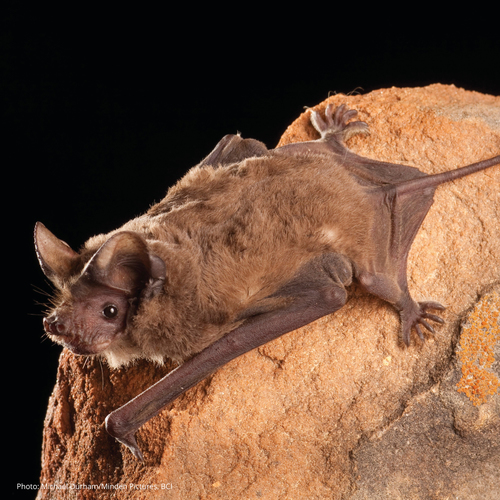
Mexican free-tailed bat
The Mexican free-tailed bat (*Tadarida brasiliensis*), also known as the Brazilian free-tailed bat, is a medium-sized bat native to the Americas and is one of the most abundant mammals in North America. This species plays a crucial role in its ecosystem, primarily through insect control. They are known for forming some of the largest colonies in the world, with some caves housing millions of individuals. These bats are famous for their spectacular evening emergences, which are a significant tourist attraction in some regions. Culturally, they are sometimes viewed as pests, but their ecological benefits far outweigh any perceived negatives.
7.9-9.8 cm
Length
28-35 cm
Wingspan
Near Threatened
Conservation Status
Distribution
The Mexican free-tailed bat has a wide range, extending from the southern United States through much of Mexico, Central America, and into South America as far south as Argentina and Chile. They are also found in the Caribbean. Significant migratory populations are found in the US, moving south into Mexico and beyond for the winter.
Lifespan
Up to 18 years in the wild, though the average is likely lower.
Mexican free-tailed bat's Habitat
Habitat Types
Caves, Mines, Bridges, Buildings, Hollow trees
Climate Zones
Temperate, Subtropical, Tropical
Adaptations
These bats are highly adaptable to various roosting sites, but caves are preferred for large maternity colonies. Their ability to utilize man-made structures has allowed them to thrive in urbanized areas. They can tolerate relatively dry conditions, often found in arid and semi-arid environments.
Variations
Several subspecies are recognized, differing slightly in size and coloration, reflecting adaptations to local environments. For instance, populations in the southwestern US are known for their vast migrations, while some Caribbean populations may be less migratory.
Appearance
Breeding Plumage
No significant difference in plumage between breeding and non-breeding seasons. Fur color is generally brown to gray.
Seasonal Feather Changes
No significant seasonal variations.
Sex Based Plumage Differences
Minimal
Notable Features
Short, dense fur, Broad ears, Wrinkled lips, Tail extends beyond the tail membrane (hence 'free-tailed')
Diet and Feeding
Primary Foods
Moths, Beetles, Flies, Ants, Other flying insects
Foraging Behavior
Mexican free-tailed bats are aerial insectivores, feeding on insects while in flight. They typically emerge from their roosts at dusk and fly high in the sky to forage, using echolocation to locate and capture prey. They can consume vast quantities of insects, sometimes up to their own body weight in a single night.
Specializations
Their echolocation is highly sophisticated, allowing them to detect small insects in complete darkness. They are also fast and agile fliers, capable of reaching high altitudes and covering long distances during foraging.
Seasonal Diet Variations
Diet composition varies depending on insect availability, which fluctuates seasonally. Moth consumption is particularly high during certain times of the year.
Behavior
Social Structure
Highly social, forming some of the largest colonies of any mammal. These colonies can number in the millions, particularly in maternity roosts.
Communication
Echolocation (for navigation and foraging), Vocalizations (social calls, mother-pup recognition), Scent marking (territoriality, mate attraction)
Migration
Many populations undertake long-distance migrations, traveling hundreds of miles between summer and winter roosts. The triggers for migration are not fully understood but likely involve temperature and food availability.
Territorial or Group Behaviors
Males may defend small territories within roosts during the breeding season. The large colonies provide protection from predators through sheer numbers.
Conservation
Threats
Habitat loss (roost destruction), Pesticide use (reducing insect prey), Wind turbine collisions, Climate change (altering insect populations and roosting conditions), Human disturbance
Protection Programs
Cave protection and management, Public education and outreach, Research on bat-friendly wind turbine operation
Local National Laws
Protected under various state and federal laws in the US, and similar protections exist in other parts of their range.
Population Trend
Decreasing
Population Estimates
While still numerous, populations have declined in some areas. Accurate estimates are difficult due to the vast colony sizes and migratory nature.
Interesting Facts
They are among the fastest mammals on Earth.
Their horizontal flight speed can reach up to 100 mph (160 km/h), aided by their streamlined bodies and long, narrow wings.
They can fly at extremely high altitudes.
Mexican free-tailed bats have been recorded flying at altitudes of over 10,000 feet (3,000 meters).
Their colonies can consume tons of insects each night.
This provides a valuable ecosystem service by controlling agricultural pests and reducing the need for pesticides.
Faqs about Mexican free-tailed bat
Are Mexican free-tailed bats dangerous to humans?
No, they are not aggressive and rarely come into direct contact with humans. Like all mammals, they can carry rabies, but the incidence is low. It's best to avoid handling bats.
Do they all migrate?
Not all populations migrate. Some are resident year-round, while others undertake long-distance migrations.
What can I do to help bats?
You can support bat conservation by protecting roosting sites, avoiding pesticide use, and educating others about the importance of bats.
Copyright @ Nature Style Limited. All Rights Reserved.
 English
English